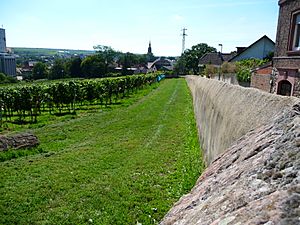Niersteiner Glöck facts for kids
The Niersteiner Glöck is a very special vineyard in Germany. It's like a small, walled garden for growing grapes. This vineyard is located in a town called Nierstein, which is in the Rheinhessen area.
What makes Glöck so unique? Well, people say it's the oldest named vineyard in Germany! Its name has been used continuously for a very long time. Because it's so famous and important, wines made from Glöck grapes are simply labeled "Glöck." They don't even need to add the village name, Nierstein, to the label.
Since 1925, the Glöck vineyard has been owned by the government of the state of Rhineland-Palatinate. It's managed by a special winery called the State Domain Oppenheim Winery. Today, they grow two main types of grapes here: Riesling and Pinot noir.
The Special Wines of Glöck
The Niersteiner Glöck vineyard is known for making very high-quality wines. It has a special classification called "Großes Gewächs Rheinhessen." This title is given by a group called the VDP (Verband Deutscher Prädikats- und Qualitätsweingüter). It means the vineyard produces some of the best wines in the region.
The vineyard is quite small, so all the grapes grown there are of similar excellent quality. It sits on a gentle slope, about 90 to 130 meters above sea level. The slope helps the grapes get plenty of sunlight.
A very old stone wall completely surrounds the vineyard. This wall helps create a special mini-climate, or microclimate. It protects the vines and helps the grapes ripen perfectly. The wines from Glöck are known for tasting balanced, with flavors of fruit, flowers, and minerals. The soil here is also special, with a mix of red rock and light, sandy soil.
History and Its Name
The name "Glöck" has a very long history. It was first written down in a document from the year 742. This makes it the oldest single vineyard in Germany that has kept the same name!
Back in 742, a powerful leader named Carloman gave the Marienkirche (a church, later called Kilians church) in Nierstein to the diocese of Würzburg. He also included the vineyard with the church. This meant that the farmers working in the vineyard had to pay a special tax, called a tithe, to the church leaders in Würzburg. This tax was paid with fruit and wine.
The vineyard has been used for growing grapes ever since that time. The stone wall that surrounds the vineyard today was finished much later, in 1761.
People believe the vineyard got its name from the church and its bells. It's not totally clear if the name comes from the sound of the bells ringing. Or maybe it's because the church bell ringer was paid with wine from this very vineyard! Either way, the name "Glöck" shows how closely the vineyard and the church have been connected for centuries. The Kilians church is still right next to the vineyard today.



